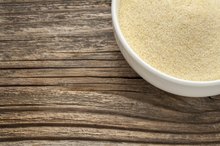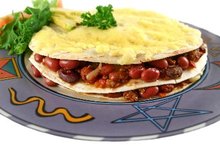Semolina Pasta & Glycemic Index
If you're diabetic, or just simply health-conscious, the glycemic index of foods is a number to keep your eye on. Made with water and either standard wheat flour or higher-quality semolina flour, pasta is a carbohydrate-rich food that has the potential to raise blood sugar levels. Compared with other starchy foods, however, semolina pasta has a relatively low glycemic index.
Semolina Pasta
Semolina flour is a refined flour made from the heart of the durum wheat kernel -- a type of hard wheat with high protein and gluten content and a relatively low carbohydrate content. The flour is mixed with water and formed into a dough, which is then extruded or forced through a metal die to produce the many classic shapes of pasta. Semolina pasta is not a whole-grain pasta. Therefore, it contains less dietary fiber, vitamins and minerals than whole-wheat pasta.
- Semolina flour is a refined flour made from the heart of the durum wheat kernel -- a type of hard wheat with high protein and gluten content and a relatively low carbohydrate content.
Glycemic Index
Can Diabetics Eat Rye Bread & Pumpernickel Bread?
Learn More
The glycemic index posits that all carbohydrate-rich foods are not created equal. The index ranks carbohydrate foods according to their effects on blood glucose levels. Low to moderate glycemic index foods produce smaller fluctuations in blood glucose and insulin levels than high glycemic index foods because they are digested and absorbed more slowly. Such foods can reduce the risk of heart disease and diabetes and are a key to sustained weight loss. Foods with a glycemic index rating over 70 are considered high on the glycemic index scale. A rating of 56 to 70 is moderate, and a rating under 56 is low.
- The glycemic index posits that all carbohydrate-rich foods are not created equal.
- The index ranks carbohydrate foods according to their effects on blood glucose levels.
Semolina Pasta Glycemic Index
Semolina pastas tend to rate low to low-moderate on the glycemic index scale. For example, angel hair pasta has a ranking of 45, white vermicelli pasta a rating of 35 and lasagna has a glycemic index of 55. In contrast, pasta made with whole-grain durum wheat flour instead of semolina flour has a glycemic index of 58. If you must adhere to a gluten-free diet, pasta made with corn flour has a ranking of 78 and pasta made with rice flour has a glycemic index of 92, both of which are very high.
- Semolina pastas tend to rate low to low-moderate on the glycemic index scale.
- If you must adhere to a gluten-free diet, pasta made with corn flour has a ranking of 78 and pasta made with rice flour has a glycemic index of 92, both of which are very high.
Glycemic Index Factors
Nutritional Information on Semolina Flour
Learn More
A number of factors can affect the glycemic index of pasta. The length of cooking time is one factor. For example, if pasta is overcooked, the carbohydrates are easier to digest, which raises the pasta's glycemic index. Pasta is typically served with vegetables that contain dietary fiber, which can slow digestion and absorption and lower the glycemic index of a pasta dish. If the pasta is served with meat or fish, the fat can also slow digestion and lower the pasta's glycemic index.
- A number of factors can affect the glycemic index of pasta.
- If the pasta is served with meat or fish, the fat can also slow digestion and lower the pasta's glycemic index.
Considerations
Low-glycemic index foods are particularly important for people with diabetes. Such foods increase blood glucose levels slowly, which puts less strain on insulin-producing cells in the pancreas. Semolina pasta, with its low level of starch and high level of protein, can be the basis of a particularly healthy dish, especially when prepared with one of the "good" fats such as olive oil and served with fiber-containing vegetables and fatty ocean fish such as salmon.
Related Articles
References
- National Pasta Association: Pasta Nutrition
- Merriam-Webster.com: Semolina
- Ojo O, Ojo OO, Adebowale F, Wang XH. The effect of dietary glycaemic index on glycaemia in patients with type 2 diabetes: A systematic review and meta-analysis of randomized controlled trials. Nutrients. 2018;10(3):373. Published 2018 Mar 19. doi:10.3390/nu10030373
- Glycemic Index and Diabetes. American Diabetes Association
- Search for the Glycemic Index. The University of Sydney
- Zeevi D, Korem T, Zmora N, et al. Personalized Nutrition by Prediction of Glycemic Responses. Cell. 2015;163(5):1079-1094. doi:10.1016/j.cell.2015.11.001+
- Sacks FM, Carey VJ, Anderson CA, et al. Effects of high vs low glycemic index of dietary carbohydrate on cardiovascular disease risk factors and insulin sensitivity: the OmniCarb randomized clinical trial. JAMA. 2014;312(23):2531-41. doi:10.1001/jama.2014.16658.
- Vega-lópez S, Venn BJ, Slavin JL. Relevance of the Glycemic Index and Glycemic Load for Body Weight, Diabetes, and Cardiovascular Disease. Nutrients. 2018;10(10). doi:10.3390/nu10101361
- Glycemic Index Database. University of Sydney. Updated October 13, 2020
- Eleazu C. O. (2016). The concept of low glycemic index and glycemic load foods as panacea for type 2 diabetes mellitus; prospects, challenges and solutions. African health sciences, 16(2), 468–479. doi:10.4314/ahs.v16i2.15
- Foster-Powell, Kaye, Holt, Susanna and Brand-Miller, Janette. "International table of glycemic index and glycemic load values: 2002." American Journal of Clinical Nutrition. 76,:1: 5-56 (2002).
- International Carbohydrate Quality Consortium, Jenkins, D. J., Willett, W. C., Astrup, A., Augustin, L. S., Baer-Sinnott, S., … Wolever, T. M. (2014). Glycaemic index: did Health Canada get it wrong? Position from the International Carbohydrate Quality Consortium (ICQC). The British journal of nutrition, 111(2), 380–382. doi:10.1017/S0007114513003905
- Leroux, MarcusFoster-Powell, Kaye, Holt, Susanna and Brand-Miller, Janette. "International Table of Glycemic Index and Glycemic Load Values: 2002." American Journal of Clinical Nutrition. Vol. 76, No. 1, 5-56, (2002).
- Lui, S., Willett, WC, et al. "A prospective study of dietary glycemic load, carbohydrate intake, and risk of coronary heart disease in US women.." American Journal of Clinical Nutrition. 71(6):1455-61. (2001).
- Mayer-Davis, E.J., Dhawan, A et al. "Towards understanding of glycaemic index and glycaemic load in habitual diet: associations with measures of glycaemia in the Insulin Resistance Atherosclerosis Study.." British Nutrition Journal. 95(2):397-405. (2006).
- Sacks, F. M., Carey, V. J., Anderson, C. A., Miller, E. R., 3rd, Copeland, T., Charleston, J., … Appel, L. J. (2014). Effects of high vs low glycemic index of dietary carbohydrate on cardiovascular disease risk factors and insulin sensitivity: the OmniCarb randomized clinical trial. JAMA, 312(23), 2531–2541. doi:10.1001/jama.2014.16658
- Salmeron, J, Manson, JE, et al. "Dietary fiber, glycemic load, and risk of non-insulin-dependent diabetes mellitus in women.." Journal of the American Medical Association. 12;277(6):472-7. (1997).
- Vega-López, S., Venn, B., & Slavin, J. (2018). Relevance of the Glycemic Index and Glycemic Load for Body Weight, Diabetes, and Cardiovascular Disease. Nutrients, 10(10), 1361. doi:10.3390/nu10101361
- Zeevi, D. Korem N. et al. Personalized Nutrition by Prediction of Glycemic ResponsesCell. 163:(5):1079-94. November 2015.
Resources
Writer Bio
Jim Thomas has been a freelance writer since 1978. He wrote a book about professional golfers and has written magazine articles about sports, politics, legal issues, travel and business for national and Northwest publications. He received a Juris Doctor from Duke Law School and a Bachelor of Science in political science from Whitman College.









